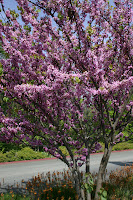 I am going to be a grandmother again! The Bushtits have built a nest in one of my hanging baskets. I have seen them going to and from this plant very frequently of late, but it never dawned on me that they might be building a nest there until yesterday. I almost pulled the thing out thinking it was dead debris from the plant! I bought this plant last November and it is pretty much done blooming for this year, so there are a lot of dead branches in it. Imagine my surprise when I realized this was not debris but a nest!
I am going to be a grandmother again! The Bushtits have built a nest in one of my hanging baskets. I have seen them going to and from this plant very frequently of late, but it never dawned on me that they might be building a nest there until yesterday. I almost pulled the thing out thinking it was dead debris from the plant! I bought this plant last November and it is pretty much done blooming for this year, so there are a lot of dead branches in it. Imagine my surprise when I realized this was not debris but a nest!Bushtits are very small gray-brown birds that most of the year gather in flocks, and travel from bush to bush, cleaning the bugs off all of the branches and leaves. (My roses have had no aphids this year.) They can look quite comical as they hang upside down to get at the insects and spiders. They are very sociable birds and will twitter to each other to keep in contact. You will hear them before you see them because they are so small and move so fast.
In the spring they pair off and mate with both parents sharing in the parental duties. They also sometimes get help in feeding their young from other Bushtits and may even build communal nests. The nest is a long, pendulous affair and apparently very warm and snug inside. For some great photos showing the construction of Bushtit nests go here.
I have only one pair (so far) in this nest and suspect that the eggs may have been laid but not hatched yet. I wondered why they picked this spot as the basket really swings in the breeze and we have been having a lot of windy days recently. However, it does offer complete protection from the neighbor's cats and other predators, except for stupid humans like me!

By the way, this basket had three plants in it when I bought it. Two were in bloom already and the third one bloomed just a few weeks ago. I have no idea what this plant is and if anyone out there knows, I'd appreciate a comment.













 This one is for my young friend Iris. I think purple is her favorite color.
This one is for my young friend Iris. I think purple is her favorite color.



